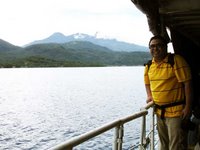 Camiguin is the second smallest province of the Philippines both in size and population. Only Batanes is smaller. But with a population density of 232 people per square kilometer, it is the 16th most densely-populated province.
Camiguin is the second smallest province of the Philippines both in size and population. Only Batanes is smaller. But with a population density of 232 people per square kilometer, it is the 16th most densely-populated province.
There are two ports in Camiguin that receive ferries from Balingoan, the one in Guinsiliban which is used by those with vehicles, and the one in Barangay Benoni in Mahinog which is the main passenger terminal since it is closer to Mambajao. There is another port in Barangay Balbagon, Mambajao but this is for Cebu-bound ferries. The fare from Balingoan is PHP100 plus a PHP7 terminal fee. The trip takes approximately an hour and 15 minutes. We left a little past 2 p.m. I arrived in Benoni at about 3:30 p.m. and took a jeepney from the terminal to Mambajao for PHP26. The trip was about 30 minutes. While on board the jeepney, I was floored by the number of ancestral homes still standing in Camiguin. The province continues to retain its character and old world charm. I would later learn after reading the DOT website that "Camiguin Island is famous for its ancestral homes gracefully dotting the streets all over the island" as well as its eight volcanoes which is why it is referred to as the island born of fire.I got off in the poblacion area and asked people at the municipio where I could find cheap lodging. Good thing there was a pension house a few meters away. I got an air-conditioned room at the GV Pension House good for two people for PHP500. A non-aircon room is PHP350.
I arrived in Benoni at about 3:30 p.m. and took a jeepney from the terminal to Mambajao for PHP26. The trip was about 30 minutes. While on board the jeepney, I was floored by the number of ancestral homes still standing in Camiguin. The province continues to retain its character and old world charm. I would later learn after reading the DOT website that "Camiguin Island is famous for its ancestral homes gracefully dotting the streets all over the island" as well as its eight volcanoes which is why it is referred to as the island born of fire.I got off in the poblacion area and asked people at the municipio where I could find cheap lodging. Good thing there was a pension house a few meters away. I got an air-conditioned room at the GV Pension House good for two people for PHP500. A non-aircon room is PHP350.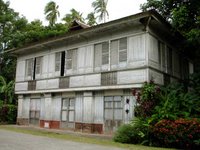 After freshening up, I went straight down to find a ride around town. I wanted to see as much as I could before dark. The hotel staff were very helpful and they got me a habal-habal which would take me to the sites in Catarman as well as the Ardent Hot Springs for just PHP300. It was worth it since he took me around for about 4 hours. The going rate for renting a motorcycle for 8 hours is PHP500 and that doesn't include gas and a driver.
After freshening up, I went straight down to find a ride around town. I wanted to see as much as I could before dark. The hotel staff were very helpful and they got me a habal-habal which would take me to the sites in Catarman as well as the Ardent Hot Springs for just PHP300. It was worth it since he took me around for about 4 hours. The going rate for renting a motorcycle for 8 hours is PHP500 and that doesn't include gas and a driver. Our first stop was the Sunken Cemetery in Barangay Bonbon, Catarman. On the way, I saw even more ancestral houses (above). As we neared Cataraman, I was treated to out of this world vistas of the Camiguin coastline, Mount Hibok-Hibok and Mount Vulcan Daan (left) up close.
Our first stop was the Sunken Cemetery in Barangay Bonbon, Catarman. On the way, I saw even more ancestral houses (above). As we neared Cataraman, I was treated to out of this world vistas of the Camiguin coastline, Mount Hibok-Hibok and Mount Vulcan Daan (left) up close. The sunken cemetery used to be part of the old capital of Camiguin. According to local historians, Mount Vulcan had four recorded eruptions. It was the third eruption in 1871 that sunk Cotta Bato and its cemetery under the sea. Remnants of the structures and gravestones were still seen during low tide but the fourth eruption in 1948 buried the area deeper by around twenty feet. In 1982, a large cross was built on the solidified lava to mark this old gravesite that has become known as the sunken cemetery and one of the world’s most unique diving sites since the coral-encrusted tombstones can be visited by divers.
The sunken cemetery used to be part of the old capital of Camiguin. According to local historians, Mount Vulcan had four recorded eruptions. It was the third eruption in 1871 that sunk Cotta Bato and its cemetery under the sea. Remnants of the structures and gravestones were still seen during low tide but the fourth eruption in 1948 buried the area deeper by around twenty feet. In 1982, a large cross was built on the solidified lava to mark this old gravesite that has become known as the sunken cemetery and one of the world’s most unique diving sites since the coral-encrusted tombstones can be visited by divers. After a few photos, we went to the ruins of the old church which was on top of a hill. The marker calls it the church of Cotta Bato, but some accounts call it the old church of Gui-ob. The walls, and parts of the belltower and convento are all that remain of this church.We then went back to the pension house so that I could change for the visit to Ardent. The hot spring was six kilometers from the poblacion in Barangay Tagdo, Mambajao. It is the most popular of Camiguin's hot springs. In the resort is a natural pool of about 40 degrees celsius coming from the bowels of Mt. Hibok-Hibok. The best time to go for a swim is late in the afternoon up to the evening, it closes at 10 p.m., so that you could really appreciate the warm water. You pay a PHP30 entrance fee.
After a few photos, we went to the ruins of the old church which was on top of a hill. The marker calls it the church of Cotta Bato, but some accounts call it the old church of Gui-ob. The walls, and parts of the belltower and convento are all that remain of this church.We then went back to the pension house so that I could change for the visit to Ardent. The hot spring was six kilometers from the poblacion in Barangay Tagdo, Mambajao. It is the most popular of Camiguin's hot springs. In the resort is a natural pool of about 40 degrees celsius coming from the bowels of Mt. Hibok-Hibok. The best time to go for a swim is late in the afternoon up to the evening, it closes at 10 p.m., so that you could really appreciate the warm water. You pay a PHP30 entrance fee. While I was getting “warmed” up, it started to rain. So I stayed in the water a bit longer hoping the rain would stop. But it didn’t. So I decided to have dinner at the place. The food was nothing great and quite expensive. It was not worth it. If it only stopped raining I would have eaten dinner in the town proper.Since it didn’t seem like the rain would stop, I decided to leave when the rain started to weaken. All I could remember was that I was shivering all the way back since I was soaking wet, the temperature was quite cold, and it was drizzling. I went straight to bed as soon as I got back to the pension house since I lacked sleep and I needed to be up at 5 a.m. the next day.
While I was getting “warmed” up, it started to rain. So I stayed in the water a bit longer hoping the rain would stop. But it didn’t. So I decided to have dinner at the place. The food was nothing great and quite expensive. It was not worth it. If it only stopped raining I would have eaten dinner in the town proper.Since it didn’t seem like the rain would stop, I decided to leave when the rain started to weaken. All I could remember was that I was shivering all the way back since I was soaking wet, the temperature was quite cold, and it was drizzling. I went straight to bed as soon as I got back to the pension house since I lacked sleep and I needed to be up at 5 a.m. the next day.
More photos of Camiguin in Multiply.
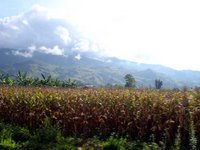 The bus left Davao City at 2:30 a.m. I tried to get as much sleep as I could but it was quite difficult since the seats were too stiff. Good thing I had the whole row to myself since there weren't a lot of passengers. So I was able to sleep on my backpack. The next thing I knew was the bus was already in Malaybalay, Bukidnon. The sun was already out but the temperature was quite cool. The climate in Malaybalay is very pleasing since it is located in a high altitude.It was back to sleep when we left the bus station and I woke up again when the bus stopped over for breakfast at a canteen in Impasug-Ong. The views of the nearby mountains were just spectacular. It reminded me that outside Metro Manila and its suburbs, so much of the Philippines is still pristine and untouched. I hope we keep these areas the way they are. From there, the road zigzagged up and down green mountains offering breathtaking views of the hilly agricultural province.I arrived at the Agora Bus Station in Cagayan de Oro at about 9 a.m. and could distinctly remember the hot and humid weather which greeted me when I got off the bus. I was told CDO has exceptionally hot weather. I waited there since my SSEAYP batchmates MJ and Simone Moneva were picking me up for breakfast.
The bus left Davao City at 2:30 a.m. I tried to get as much sleep as I could but it was quite difficult since the seats were too stiff. Good thing I had the whole row to myself since there weren't a lot of passengers. So I was able to sleep on my backpack. The next thing I knew was the bus was already in Malaybalay, Bukidnon. The sun was already out but the temperature was quite cool. The climate in Malaybalay is very pleasing since it is located in a high altitude.It was back to sleep when we left the bus station and I woke up again when the bus stopped over for breakfast at a canteen in Impasug-Ong. The views of the nearby mountains were just spectacular. It reminded me that outside Metro Manila and its suburbs, so much of the Philippines is still pristine and untouched. I hope we keep these areas the way they are. From there, the road zigzagged up and down green mountains offering breathtaking views of the hilly agricultural province.I arrived at the Agora Bus Station in Cagayan de Oro at about 9 a.m. and could distinctly remember the hot and humid weather which greeted me when I got off the bus. I was told CDO has exceptionally hot weather. I waited there since my SSEAYP batchmates MJ and Simone Moneva were picking me up for breakfast. We went straight to Rosario Arcade in Limketkai for a buffet breakfast at East Wok, a Chinese restaurant. The food was filling especially after the long trip from Davao. After breakfast, we passed by the Misamis Oriental Capitol for a while since MJ had to meet a client. So I was able to go around the capitol grounds with Sim. There was a provincial tourism and trade fair on the grounds so we went around to check it out.
We went straight to Rosario Arcade in Limketkai for a buffet breakfast at East Wok, a Chinese restaurant. The food was filling especially after the long trip from Davao. After breakfast, we passed by the Misamis Oriental Capitol for a while since MJ had to meet a client. So I was able to go around the capitol grounds with Sim. There was a provincial tourism and trade fair on the grounds so we went around to check it out.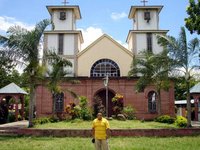 After that, we drove north towards Jasaan since I wanted to visit the church which was declared a national cultural treasure in 2001. On the way, we dropped Simone off at the Polymedic Hospital in Tagoloan since she had to meet her patients.
After that, we drove north towards Jasaan since I wanted to visit the church which was declared a national cultural treasure in 2001. On the way, we dropped Simone off at the Polymedic Hospital in Tagoloan since she had to meet her patients.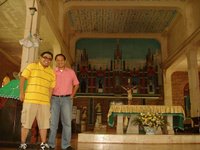 I was not quite impressed with the Jasaan Church. If it were compared to other churches in the country, it would look quite ordinary. It reminded me of my impressions of the churches in Tabaco, Albay and Bacong, Negros Oriental. I guess they declared it since it was the best-preserved church in Misamis Oriental and rare since it was in Mindanao. Built by the Jesuits in the late 19th to early 20th century, I think a more significant element of the church is its convent, an old wooden structure with huge wooden posts.
I was not quite impressed with the Jasaan Church. If it were compared to other churches in the country, it would look quite ordinary. It reminded me of my impressions of the churches in Tabaco, Albay and Bacong, Negros Oriental. I guess they declared it since it was the best-preserved church in Misamis Oriental and rare since it was in Mindanao. Built by the Jesuits in the late 19th to early 20th century, I think a more significant element of the church is its convent, an old wooden structure with huge wooden posts.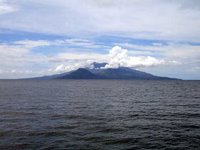 In Jasaan, I waited for a bus to the ferry terminal in Balingoan which was still an hour away. I spent PHP50 for the bus ride. There used to be fastcrafts from Cagayan de Oro to Camiguin but since some politicians in Camiguin wanted to earn from it as well, the operator had no choice but to increase his fare to accommodate this unnecessary expense. As a result, people still used the ferry service in Balingoan and the one from CDO was forced to close. So one has no choice but to use this slow ferry service to the island.
In Jasaan, I waited for a bus to the ferry terminal in Balingoan which was still an hour away. I spent PHP50 for the bus ride. There used to be fastcrafts from Cagayan de Oro to Camiguin but since some politicians in Camiguin wanted to earn from it as well, the operator had no choice but to increase his fare to accommodate this unnecessary expense. As a result, people still used the ferry service in Balingoan and the one from CDO was forced to close. So one has no choice but to use this slow ferry service to the island.
More photos of Misamis Oriental in Multiply.
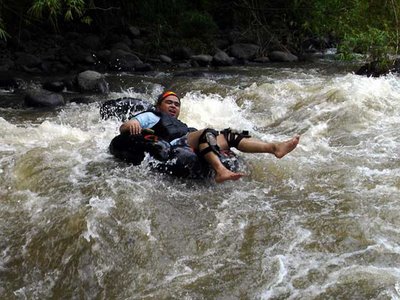 Today, it was time to get wet and wild in Santa Cruz, Davao del Sur which is known for its whitewater tubing in the Sibulan River in Darong, a barangay quite close to the boundary of Davao City.
Today, it was time to get wet and wild in Santa Cruz, Davao del Sur which is known for its whitewater tubing in the Sibulan River in Darong, a barangay quite close to the boundary of Davao City.
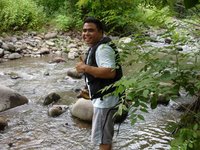 If you don’t have a car, you could simply take any public transportation going towards the direction of Santa Cruz. Although you will have to keep your eye open since there isn’t any signage along the highway pointing towards the attraction. Look out for the sign pointing to Barangay Sibulan and the Ayala Agricultural Development Corporation and make a right there.
If you don’t have a car, you could simply take any public transportation going towards the direction of Santa Cruz. Although you will have to keep your eye open since there isn’t any signage along the highway pointing towards the attraction. Look out for the sign pointing to Barangay Sibulan and the Ayala Agricultural Development Corporation and make a right there.
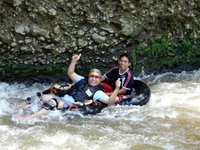 It’s about 100 meters from the national highway and the road is quite bumpy. You’ll know you’re in the right place if you see a copra processing area. The base camp of the whitewater tubing is in front of the Ayala Canteen. Just ask around if you’re not sure but you make a left there into an open space used for parking. Don’t be surprised when you see an extra PHP40 in your bill since they charge for parking.
It’s about 100 meters from the national highway and the road is quite bumpy. You’ll know you’re in the right place if you see a copra processing area. The base camp of the whitewater tubing is in front of the Ayala Canteen. Just ask around if you’re not sure but you make a left there into an open space used for parking. Don’t be surprised when you see an extra PHP40 in your bill since they charge for parking.
 The whitewater tubing at Darong is quite affordable since you won’t spend more than PHP400 per head. You basically pay for a guide which is one is to one, rental fees for the tube and the gear and the habal-habal (motorcycle) ride up to the starting point.It’s a muddy and rocky road up to the starting point. And from the road, you will have to walk about 100 more meters down to the river along a slippery and muddy trail. So better make sure you bring a trusty pair of sandals since I was wearing slippers and ended up having to take them off.
The whitewater tubing at Darong is quite affordable since you won’t spend more than PHP400 per head. You basically pay for a guide which is one is to one, rental fees for the tube and the gear and the habal-habal (motorcycle) ride up to the starting point.It’s a muddy and rocky road up to the starting point. And from the road, you will have to walk about 100 more meters down to the river along a slippery and muddy trail. So better make sure you bring a trusty pair of sandals since I was wearing slippers and ended up having to take them off.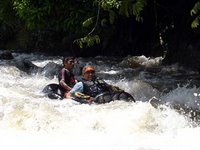 Anyway, I was relieved when we finally got to the river since it was simply fun, fun, fun all the way down to the base camp. Better be ready for some scratches and small bruises here and there but there’s nothing to worry about since the guides are very experienced.
Anyway, I was relieved when we finally got to the river since it was simply fun, fun, fun all the way down to the base camp. Better be ready for some scratches and small bruises here and there but there’s nothing to worry about since the guides are very experienced.
You’ll definitely fall off the tube at one or two of the rapids so don’t panic since the water is quite shallow. Just hold on to the tube and try to keep your legs up so you do not hit the rocks. Anyway, your guide will be there to hold on to you if you aren’t able to grip the tube.
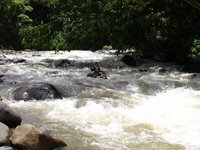 It would take about 2 hours to complete the basic route. I fell once during this run. But I escaped with just a few scratches and a sore toe which hit one of the rocks while I was on the tube. Hehe! But if I had more time, I would have done a second round or started from a higher point. Also try to avoid going here on a weekend if you want the river and the base camp all to yourself. It seemed we were the only clients for the day. Hehe!
It would take about 2 hours to complete the basic route. I fell once during this run. But I escaped with just a few scratches and a sore toe which hit one of the rocks while I was on the tube. Hehe! But if I had more time, I would have done a second round or started from a higher point. Also try to avoid going here on a weekend if you want the river and the base camp all to yourself. It seemed we were the only clients for the day. Hehe!
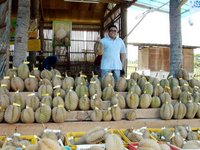 On the way back to Davao City, we were able to spot a durian stand selling the fruit for as low as PHP25 a kilo. The arancillo variety we got was PHP40 a kilo and it was much better than the one I had the night before. Indeed it tastes like heaven but I think the part which says it smells like hell is quite exaggerated since it wasn’t that bad.
On the way back to Davao City, we were able to spot a durian stand selling the fruit for as low as PHP25 a kilo. The arancillo variety we got was PHP40 a kilo and it was much better than the one I had the night before. Indeed it tastes like heaven but I think the part which says it smells like hell is quite exaggerated since it wasn’t that bad.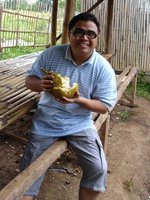 There were vendors also selling marang so how could I resist. I got one piece for PHP20. So we had fruits for our late breakfast. One thing I wasn’t able to try out though was mangosteen. Maybe I will during my next visit to Davao.I was planning to visit the Philippine Eagle Research and Nature Center but since I had been there already, we decided instead to rush back to the city proper for a late lunch since we wanted to catch the buy one, take one pizzas at Picobello, a classy Italian restaurant in the Gaisano South Ilustre mall which is frequented by Davao expats in the evenings. This promo is available only from 2 to 5 p.m. I spent about PHP260 for the two pizzas we ordered.
There were vendors also selling marang so how could I resist. I got one piece for PHP20. So we had fruits for our late breakfast. One thing I wasn’t able to try out though was mangosteen. Maybe I will during my next visit to Davao.I was planning to visit the Philippine Eagle Research and Nature Center but since I had been there already, we decided instead to rush back to the city proper for a late lunch since we wanted to catch the buy one, take one pizzas at Picobello, a classy Italian restaurant in the Gaisano South Ilustre mall which is frequented by Davao expats in the evenings. This promo is available only from 2 to 5 p.m. I spent about PHP260 for the two pizzas we ordered.
 For dinner, I met up with my SSEAYP batchmate Steve who took me to Jack’s Ridge, a popular dining area which offers a commanding view of the city’s skyline (right) and the Davao Gulf. The ridge was actually the headquarters of the retreating Japanese forces towards the end of the Second World War and is replete with caves dug up by the Japanese as well as bullets and other war materials in the rocky soil. There is also rumor that somewhere in the caves is hidden part of the Yamashita loot.
For dinner, I met up with my SSEAYP batchmate Steve who took me to Jack’s Ridge, a popular dining area which offers a commanding view of the city’s skyline (right) and the Davao Gulf. The ridge was actually the headquarters of the retreating Japanese forces towards the end of the Second World War and is replete with caves dug up by the Japanese as well as bullets and other war materials in the rocky soil. There is also rumor that somewhere in the caves is hidden part of the Yamashita loot.
 Anyway, after that great dinner, I rushed to the Matina Town Square since I was going to meet more of my Davao brods at Kanto Bar. We had an interesting discussion and ended quite late. To make the long story short, we got to the bus terminal quite late and the next bus leaving for Cagayan de Oro was still at 2:30 a.m. The last aircon bus leaves at 10 p.m. so I had to make do with the de luxe buses. I wonder why they call the non-aircon buses de luxe. Hehe! I paid PHP365 for the seven hour trip from Davao City to Cagayan de Oro.
Anyway, after that great dinner, I rushed to the Matina Town Square since I was going to meet more of my Davao brods at Kanto Bar. We had an interesting discussion and ended quite late. To make the long story short, we got to the bus terminal quite late and the next bus leaving for Cagayan de Oro was still at 2:30 a.m. The last aircon bus leaves at 10 p.m. so I had to make do with the de luxe buses. I wonder why they call the non-aircon buses de luxe. Hehe! I paid PHP365 for the seven hour trip from Davao City to Cagayan de Oro.
More photos of Davao del Sur and Davao City in Multiply.
 Camiguin is the second smallest province of the Philippines both in size and population. Only Batanes is smaller. But with a population density of 232 people per square kilometer, it is the 16th most densely-populated province.
Camiguin is the second smallest province of the Philippines both in size and population. Only Batanes is smaller. But with a population density of 232 people per square kilometer, it is the 16th most densely-populated province. I arrived in Benoni at about 3:30 p.m. and took a jeepney from the terminal to Mambajao for PHP26. The trip was about 30 minutes. While on board the jeepney, I was floored by the number of ancestral homes still standing in Camiguin. The province continues to retain its character and old world charm. I would later learn after reading the DOT website that "Camiguin Island is famous for its ancestral homes gracefully dotting the streets all over the island" as well as its eight volcanoes which is why it is referred to as the island born of fire.
I arrived in Benoni at about 3:30 p.m. and took a jeepney from the terminal to Mambajao for PHP26. The trip was about 30 minutes. While on board the jeepney, I was floored by the number of ancestral homes still standing in Camiguin. The province continues to retain its character and old world charm. I would later learn after reading the DOT website that "Camiguin Island is famous for its ancestral homes gracefully dotting the streets all over the island" as well as its eight volcanoes which is why it is referred to as the island born of fire. After freshening up, I went straight down to find a ride around town. I wanted to see as much as I could before dark. The hotel staff were very helpful and they got me a habal-habal which would take me to the sites in Catarman as well as the Ardent Hot Springs for just PHP300. It was worth it since he took me around for about 4 hours. The going rate for renting a motorcycle for 8 hours is PHP500 and that doesn't include gas and a driver.
After freshening up, I went straight down to find a ride around town. I wanted to see as much as I could before dark. The hotel staff were very helpful and they got me a habal-habal which would take me to the sites in Catarman as well as the Ardent Hot Springs for just PHP300. It was worth it since he took me around for about 4 hours. The going rate for renting a motorcycle for 8 hours is PHP500 and that doesn't include gas and a driver. Our first stop was the Sunken Cemetery in Barangay Bonbon, Catarman. On the way, I saw even more ancestral houses (above). As we neared Cataraman, I was treated to out of this world vistas of the Camiguin coastline, Mount Hibok-Hibok and Mount Vulcan Daan (left) up close.
Our first stop was the Sunken Cemetery in Barangay Bonbon, Catarman. On the way, I saw even more ancestral houses (above). As we neared Cataraman, I was treated to out of this world vistas of the Camiguin coastline, Mount Hibok-Hibok and Mount Vulcan Daan (left) up close. The sunken cemetery used to be part of the old capital of Camiguin. According to local historians, Mount Vulcan had four recorded eruptions. It was the third eruption in 1871 that sunk Cotta Bato and its cemetery under the sea. Remnants of the structures and gravestones were still seen during low tide but the fourth eruption in 1948 buried the area deeper by around twenty feet. In 1982, a large cross was built on the solidified lava to mark this old gravesite that has become known as the sunken cemetery and one of the world’s most unique diving sites since the coral-encrusted tombstones can be visited by divers.
The sunken cemetery used to be part of the old capital of Camiguin. According to local historians, Mount Vulcan had four recorded eruptions. It was the third eruption in 1871 that sunk Cotta Bato and its cemetery under the sea. Remnants of the structures and gravestones were still seen during low tide but the fourth eruption in 1948 buried the area deeper by around twenty feet. In 1982, a large cross was built on the solidified lava to mark this old gravesite that has become known as the sunken cemetery and one of the world’s most unique diving sites since the coral-encrusted tombstones can be visited by divers. After a few photos, we went to the ruins of the old church which was on top of a hill. The marker calls it the church of Cotta Bato, but some accounts call it the old church of Gui-ob. The walls, and parts of the belltower and convento are all that remain of this church.
After a few photos, we went to the ruins of the old church which was on top of a hill. The marker calls it the church of Cotta Bato, but some accounts call it the old church of Gui-ob. The walls, and parts of the belltower and convento are all that remain of this church. While I was getting “warmed” up, it started to rain. So I stayed in the water a bit longer hoping the rain would stop. But it didn’t. So I decided to have dinner at the place. The food was nothing great and quite expensive. It was not worth it. If it only stopped raining I would have eaten dinner in the town proper.
While I was getting “warmed” up, it started to rain. So I stayed in the water a bit longer hoping the rain would stop. But it didn’t. So I decided to have dinner at the place. The food was nothing great and quite expensive. It was not worth it. If it only stopped raining I would have eaten dinner in the town proper.














